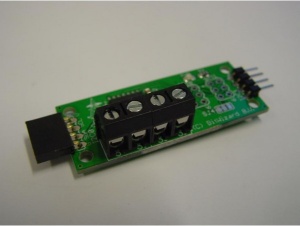Thermocouple
This is the documentation page for the Thermocouple, that you can buy in the BitWizard shop.
Overview
The Thermocouple has a low voltage of max about 75mV. The low voltage is temperature sensitive, so that makes it possible to read the temperature with it.
The board has 4 pins, which can be changed to input or output.
Assembly instructions
None: the board comes fully assembled.
Possible Configurations
External resources
Datasheets
Additional software
Related projects
Pinout
For the SPI connector see: SPI_connector_pinout.
Normal measurements would return a value of 0 for 0V up to 1023 for the reference value.
| value | thermo |
|---|---|
| 0x00 | T4 |
| 0x01 | T3 |
| 0x02 | T2 |
| 0x03 | T1 |
The jumper has: 1: GND, 2: DEV POWER, 3: 5V (from SPI).
Put the jumper on 2-3 to use the SPI power (from the arduino? i.e. from USB? -> max at most 400 mA!)
Use a connector on 1-2 to provide a more powerful power source for the devices that the board drives.
More info you can read at analog inputs.
LEDs
Power connector
The connector SV2 allows you to connect the "power source".
(*) The datasheet for the used transistors mentions "20V", but is is always prudent to keep some margin.
If you want 5V as the power source, you could put a jumper on pin 2-3. In that case you will have to be aware that you're using the 5V power from the rest of the system. This will be limited by e.g. USB power limits, other devices on the SPI bus, cable thickness and connector capability. But for low-current 5V applications this might be useful.
Jumper settings
See solder jumpers on how to change the solder jumper.
By changing the solder jumper SJ1, you can make the connector nearest the board edge into the ICSP programming connector for the attiny44 on the board.
Powering Thermocouple
Although some BitWizard boards will work with 3.3V as the power supply, the Thermocouple board needs to be supplied with 5V as this voltage is used to drive.
Protocol
To make the Thermocouple be useful, you need to send things over the SPI or I2C bus to the PCB.
The general overview of the protocol is here.
The specific commands for the Thermocouple PCB are explained on the page about the spi_dio board, as the two boards share the same protocol: DIO_protocol .
For arduino, a sample PDE is available, called ardemo_lcd.pde, also at the BitWizard software download directory .
This is a demo to send things using SPI to the lcd board. The SPI routines there are applicable for the dio and Thermocouple boards as well.
The software
Default operation
Future hardware enhancements
Future software enhancements
Useful links
The Thermocouple BitWizard shop page
Analog inputs
DIO protocol
SPI connector pinout
